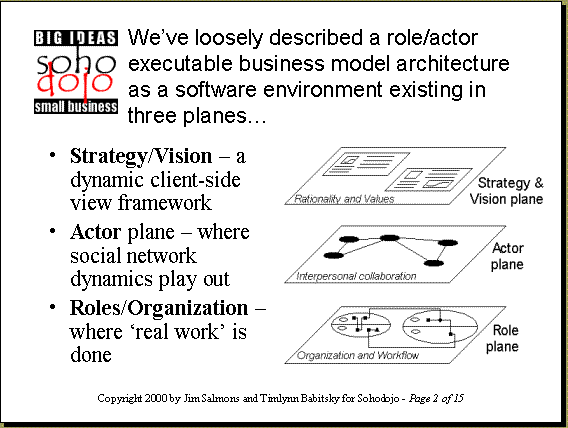![]() Complaint? Irritation? Suggestion?
Complaint? Irritation? Suggestion?
Tell us, please.

An Applied R&D Lab Serving Solo and Family-based Entrepreneurs in Rural and Distressed Urban Communities
The Nanocorp Primer #3
Role/Actor Scenario Patterns
The A-Team and the Sandbox - A Pattern to Enable Nanocorp Replication (AKA New Economy Job Creation)
| << Previous slide] [Next slide >> |

|
| << Previous slide] [ Back to first slide ] [Next slide >> |
Nanocorp Collaboration in a Multi-dimensional Mirror World

Check out our Rants and Raves newsletter article, 'Collaboration: The Foundation of Entrepreneurial Free Agency', for our perspective on this important free agent and webpreneur trait and to learn more about Michael Schrage's exciting book, 'No More Teams'.
Strategy & Vision Views onto your Mirror World
Don't jump to the conclusion that the '3-planes' system domain diagram is a literal layered system architecture. Certainly there are relevant insights that you can take from this overview diagram.

For example, the System & Vision plane is largely a role/actor-aware User Interface framework which understands the underlying meta-model constructs of the 'Mirror Worlds'-like executable model. Given a desktop owner or model-portal log-on, it is the responsibility of this UI framework to dynamically render use-configurable and user-specific views on the state of the executing model.
Depending on implementation-specific design decisions, this UI framework may be client-side or server-side. In either case, it is most likely that the actual encoding and transmission of model-state data will be XML-based.
This isn't about websites and web applications...
The hypergraphical Actor/Person and Role/Organization planes, however, will almost certainly be implemented using server-based technologies. Instead of today's website or web application destinations, 'elastically networking entrepreneurial free agent' users will dynamically and asynchronously attach to, and participate in, persistently-executing model-spaces.
Note that the model-space does not need to be omnipotent; that is, everyone does not need to 'play' within one monolithic, proprietary model-space. Rather, the open interface standard of an Open Source role/actor executable business model technology platform supports, in fact encourages, multiple concurrent model-serving hosts. An open interface will allow model elements to be mobile among these independently owned and operated model-space hosts.
Slide text
Think of a role/actor executable business model architecture as a software environment existing in three planes...
- Strategy/Vision -- a dynamic client-side view framework
- Actor plane -- where social network dynamics play out
- Roles/Organization -- where 'real work' is done
<< Previous slide] [ Back to first slide ] [Next slide >>
